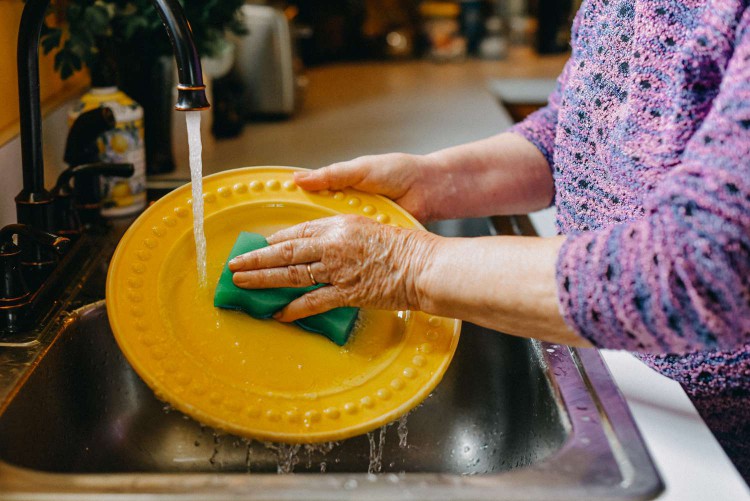- Changing out regularly used household items like kitchen sponges and pillows may help consumers avoid potential infections and other health issues.
- Often times factors other than appearance—like smell—can indicate whether or not something needs to be replaced.
- Experts recommend maintaining the recommended frequency of replacing certain products to keep your home safe and healthy.
When was the last time you changed out the household items you use every day?
While staples like humidifiers or kitchen sponges may still work long past their shelf life, experts note the importance of regularly changing out household items in order to avoid infections and other health issues.
“Not replacing these [household] items opens us up to the possibility of possible infections, respiratory and skin health issues,” Kara Wada, MD, an allergy specialist at The Ohio State University Wexner Medical Center and an associate professor at The Ohio State University College of Medicine, told Health.
According to Wada, some products like nonstick cookware or plastic food containers may result in exposure to certain chemicals when they are used past their prime. These chemicals often have known effects on hormone and immune system health; some items may also be associated with an increased risk of certain cancers.
Here are the items experts recommend replacing regularly, along with tips on how to recognize when it’s time to say goodbye.

Getty Images / Stefania Pelfini, La Waziya Photography
Pillows
Pillows, including decorative ones on beds and couches, collect dead skin cells and bacteria over time, which can cause or worsen allergies and promote breakouts, Melanie Palm, MD, a board-certified dermatologist at Art of Skin MD in San Diego, CA, told Health.
Pillows can also harbor dust mites, which can cause allergy symptoms year-round.
Palm recommends replacing pillows every 1 to 2 years, but there are some things you can do in between replacement windows to keep your pillows clean and hygienic.
For instance, a hypoallergenic pillow cover can protect your pillows from stains, dust mites, and bed bugs. Palm also recommends throwing your pillows into the dryer on high heat for 10 to 15 minutes every 1 to 2 months to help disinfect and manage dust mites.
If your pillows are poly-filled meaning it’s stuffed with synthetic polyester fibers, Wada suggests replacing them yearly. “The amount of dust mites and dust mite allergen in them increases considerably the longer we have them," she said.
Mattresses
Just like pillows, mattresses collect dead skin, bacteria, dust mites, and fungus over time, said Palm. These can be “hazardous to your health” especially if you have sensitive skin or suffer from skin allergies or asthma.
“Dead skin cells and bacteria on your mattress attract dust mites and tiny bugs that leave droppings on your mattress that can cause contact dermatitis, skin irritation, hives, or worsen an existing asthma condition,” she said.
If you regularly vacuum your mattress and use a hypoallergenic mattress protector that blocks out dust mites and dead skin cells, Palm said you can likely get away with replacing it every 7 years. If not, she recommends replacing it every 5 years—unless you're experiencing irritation, in which case you should replace the mattress immediately.
Besides vacuuming your mattress and using protective covers, wash your bed sheets every week, remove excess items on the bed (like stuffed animals and decorative pillows), and ban pets from the bedroom to help keep dust mites at bay.
The 10 Best Mattress Brands for Every Type of Sleeper
Loofahs and Bath Sponges
According to Wada, loofahs and bath sponges harbor bacteria, mold, and mildew in their nooks and crannies—especially when they are stored in a damp shower or bathroom. Using a dirty loofah or bath sponge can be a "trigger for allergies, asthma, skin infections, or acne over time."
Palm explained these commonly used items can expose your skin to bacteria and fungi that may cause rashes, irritation, or itchy skin. Additionally, if you're showering with open wounds or broken skin, a dirty loofah or sponge can lead to an infection after bacteria enters the skin.
Tania Elliot, MD, an allergist and immunologist based in New York City said loofahs and bath sponges can also grow mold, which can lead to the development of congestion, itching, sneezing, sinus issues, and headaches, particularly if you have an allergy.
If you must use a loofah or bath sponge, Elliot suggests getting a new one every 2 to 4 weeks. If your loofah has a funky smell before this time mark, it is probably a sign to toss it.
If you can do without a loofah or bath sponge, it's best to opt out. Instead, using a washcloth that can be washed regularly is a much safer, cleaner option, Wada said.
Nonstick Pans
Nonstick pans do not last forever. If you notice the coating is chipped then it means it’s time to throw out the pan and start fresh.
Many of the coatings found on nonstick pans contain PFAS, “also known as forever chemicals, which have been implicated in many health problems,” Wada said. “If the coating is chipped, we are more likely to ingest these chemicals."
According to the Centers for Disease Control and Prevention (CDC), PFAS can cause damage to the liver and immune system. They have also caused low birth weight, birth defects, delayed development, and newborn deaths in lab animals.
How often you replace nonstick pans will depend on how frequently you use them. If the coating is chipped, you should replace them immediately.
Cook Healthier Meals With This 5-Piece Lodge Cast Iron Bundle That's Now 40% Off
Cutting Boards
Cutting boards that have deep grooves can be tough to properly clean out, which means bacteria, mold, and viruses can grow in there, Elliot said.
This can lead to possible contamination of food or even result in infection.
A cutting board that is well taken care of can last at least a year and others like wooden ones may last up to five. However, if your cutting board has any deep groves, it’s time to replace them.
Elliot said you can persevere cutting boards and avoid contamination by washing them in hot, soapy water, avoiding cutting meat and veggies on the same board, and sanitizing it with a bleach solution (1 tbsp of bleach in a gallon of water) at least monthly, depending on how often you cook.
Kitchen Sponges
Kitchen sponges, like loofahs, can harbor bacteria and can be contaminated with mold and mildew, Wada said.
In fact, a 2017 study found 362 different species of bacteria live in used kitchen sponges. The density of bacteria reached up to 45 billion per square centimeter.
This basically means there are spots on your kitchen sponge that may have just as high concentrations of bacteria as a toilet.
Wada recommends replacing kitchen sponges every two weeks, but it may be earlier if you notice any visible signs of mold or mildew. If the sponge smells funky, that's another sign to toss it.
Wada suggests sanitizing kitchen sponges in the dishwasher every other day, if possible. “This minimizes the spread of bacteria and lessens the chance of them being contaminated with mold/mildew,” she said.
Plastic Storage Containers
Over time, plastic storage containers can get scratched, damaged, or stained. In some cases, this kind of wear and tear can allow bacteria to reside in them as well, posing a food safety risk.
Plus, some “plastics contain substances like BPAs and related compounds that can affect our hormone health and increase our risk of certain cancers,” Wada said.
Normally, plastic food containers should be replaced every six months to a year, but if they are scratched or etched, you should replace them right away, Wada said. Instead of using plastic containers, she suggests switching to glass options when possible.
Humidifier
Although humidifiers can be effective for treating dryness of the nose, throat, and lips or even prevent transepidermal water loss while sleeping, most people don’t realize that they can also be a breeding ground for harmful bacteria and mold, according to Palm.
“While most people know to clean out their humidifiers at least once a week, many don’t realize that the filter or water panel needs to be replaced over time,” she said.
If humidifiers are not replaced, you may be exposed to bacteria and mold that grows in humidifier filters.
Palm recommends replacing filters or water panels of humidifiers at least every 1 to 2 months. But if you want to avoid the hassle of doing that, she suggests an ultrasonic humidifier with a permanent ceramic filter, which traps impurities in the water.
Vents
According to Elliot, vents in your air conditioner unit can collect dust and other airborne particles, like pollen. The amount of particles and debris collected in vents will vary depending on location, with a greater risk in high air pollution and severe fire season areas.
“When you turn on your AC at the start of the season, it will send those allergens into the air which can trigger coughing, sneezing, and congestion,” Elliot said.
If you have an AC unit, she suggests changing the vents in your unit every 3 to 6 months. Avoiding this not only compromises clean air but may cause your heating and AC systems to be prone to more breakdowns.








